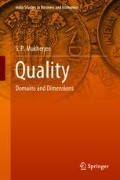Abstract
The word ‘industry’ has, of late, acquired a comprehensive generic meaning, viz. a human enterprise that carries out the basic functions of procuring, processing and providing. Each of these functions has three discernible facets, viz. planning , executing (as planned) and verifying (to check conformity of execution with plan). In recent times, the ambit of Quality has embraced this broad definition of industry and the scope of Quality Management has expanded significantly to stimulate and absorb many new approaches, tools and techniques.
Access this chapter
Tax calculation will be finalised at checkout
Purchases are for personal use only
References
Adams, T., Ferguson, G. T., & Tobolski, J. (2001). Getting value from silent commerce to-day. Outlook.
Ang, C. L., et al. (2001). An empirical study of the use of information technology to support total quality management. Total Quality Management, 12, 145–158.
Basseville, M., & Nikiforov, I. K. V. (1993). Detection of abrupt changes, theory and applications. New Jersey: Prentice Hall.
Box, G. E. P., et al. (2003). Performance evaluation of dynamic monitoring systems: The waterfall chart. Quality Engineering, 16(2), 183–191.
Chan, L. K., & Wu, M. L. (1998). Prioritising the technical measures in quality function deployment. Quality Engineering, 10, 467–480.
Chang, L. L. et al. (1993). An expert system for ISO 9000 quality management system. In IEEE TENCON. Beijing: Hong Kong Productivity Council.
Cox, T. F. (2001). Multidimensional scaling used in multivariate statistical process control. Journal of Applied Sttistics, 28, 365–374.
Franz, E. S., & Foster, S. T., Jr. (1992). Using a knowledge-based decision support system as a total quality management consultant. International Journal of Production Research, 30(9), 2159–21272.
Garvin, D. A. (1984). What does “Product Quality” mean? Sloan Management Review, Fall, 25–43.
Ghezzi, C., Jazayeri, M., & Mandrioli, D. (1991). Fundamentals of software engineering. New Delhi: Prentice Hall of India.
Gupta, V. K., & Sagar, R. (1993). Total quality control using PC’s in an engineering company. International Journal of Production Research, 31(1), 161–172.
Hotelling, H. (1947). In Eisenhart et. al. (Ed.), Multivariate quality control in techniques for statistical analysis (pp. 111–184). New York: McGraw Hill.
Hwang, C. L., & Yoon, K. (1992). Multiple attribute decision-making: Methods and applications. Berlin: Springer Verlag.
ISO Standard 9126.
Kassicieh, C., et al. (1995). SPC-Pro: An expert system approach for variables control charts. Quality Engineering, 7, 89–104.
Khan, M. K., & Hafiz, N. (1999). Development of an expert system for implementation of ISO 9000 quality systems. Total Quality Management, 10(1), 47–59.
McCall, J. A., Richards, P. K., & Walters, G. F. (1977). Factors in software quality (Vol. 1). Springfield, VA: ADA 049014, National Technical Information Service.
Mutafelija, B., & Stromberg, H. (2003). Systematic process improvement using ISO 9001: 2000 and CMMI. Boston, MA: Artech House.
Naik, K., & Tripathy, P. (1998). Software testing and quality assurance. Hoboken: Wiley.
Pfau, D. R., & Zack, B. A. (1986). Understanding expert system shells. Computerworld Focus, 20(7A), 23–24.
Sarkar and Meeker. (1998). A Bayesian On-Line Change detection algorithm with process monitoring applications. Quality Engineering, 10(3), 539–549.
Sparks, R., Adolphson, A., & Phatak, A. (1997). A multivariate process monitoring using the dynamic biplot. International Statistical Review, 65(3), 325–350.
Weghell, M., et al. (2001). The statistical monitoring of a complex manufacturing process. Journal of Applied Statistics, 28, 409–426.
Xie, M., Tan, K. C., & Goh, H. K. (1998). Fault tree reduction for reliability analysis and improvement. In Basu, Basu, & Mukhopadhyay (Eds.), Frontiers in reliability. Singapore: World Scientific.
Author information
Authors and Affiliations
Corresponding author
Rights and permissions
Copyright information
© 2019 Springer Nature Singapore Pte Ltd.
About this chapter
Cite this chapter
Mukherjee, S. (2019). Quality—Information Technology Interface. In: Quality. India Studies in Business and Economics. Springer, Singapore. https://doi.org/10.1007/978-981-13-1271-7_14
Download citation
DOI: https://doi.org/10.1007/978-981-13-1271-7_14
Published:
Publisher Name: Springer, Singapore
Print ISBN: 978-981-13-1270-0
Online ISBN: 978-981-13-1271-7
eBook Packages: Business and ManagementBusiness and Management (R0)

